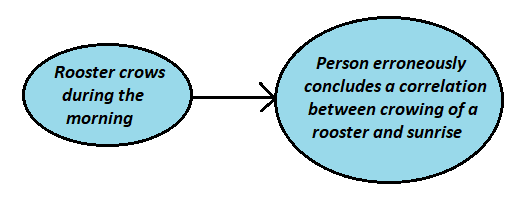Illusory Correlation refers to the belief that two variables are correlated to each other even though they are not correlated in reality. A classic example to demonstrate the concept of illusory correlation is that of a rooster crowing at sunrise.
On observing that the sun rises every day following the crowing of a rooster, a person might conclude that the crowing of the rooster somehow has an influence on the sun rising. Such a belief would in fact be erroneous. We cannot conclude any correlation between two events simply on the basis that one event occurred before the other.

The concept of illusory correlation was first identified by the research of David Hamilton and Robert Gifford in 1976. They observed that people wrongly concluded that there existed a correlation between immigration status and the tendency to commit crimes. In some ways, illusory correlations may lead to the development of prejudices and stereotypes.
Example 1 – Shoe Size and Height:
As a person grows into adulthood, the height of a person naturally increases. It is also the case, that the size of a person’s feet increases as the person grows older. On observing that shoe size and height seem to grow together, a person might erroneously conclude that there is some kind of a correlation/relationship between shoe size and height. This is an example of illusionary correlation.
Example 2 – Superstitions:
Suppose that a black cat crosses a person’s path when he is walking on the street. Later on, on facing some misfortune the person may blame the black cat for the misfortune. This is an example of an illusionary correlation. Many other superstitions such as planets having an effect on people’s lives, etc. are all examples of illusory correlation.

Why is illusory correlation important in psychology?
The concept of illusory correlation is important in psychology because such kinds of erroneous beliefs indicate the presence of a bias. This demonstrates how an average human might be lead into believing in various prejudices and superstitions with no basis in reality.
Confirmation bias, prejudice, and superstition are all strongly associated with illusory correlation.